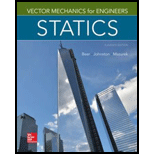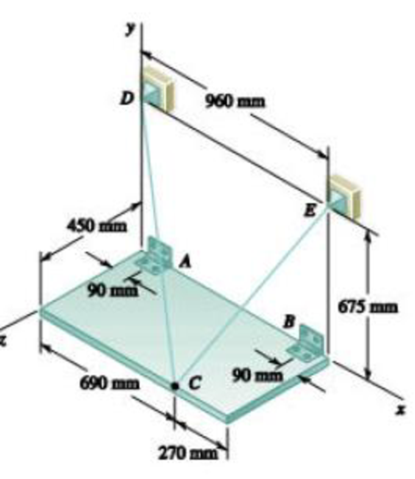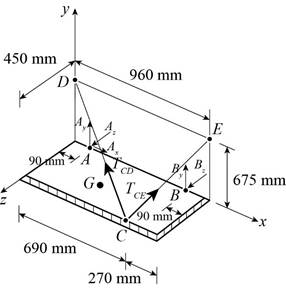
Concept explainers

PROBLEM 4.117
A 100-kg uniform rectangular plate is supported in the position shown by hinges A and B and by cable DCE that passes over n frictionless hook at C. Assuming that the tension is the same in both parts of the cable, determine (a) the tension in the cable, (b) the reactions at A and B. Assume that the hinge at B does not exert any axial thrust.
(a)
The tension on the cable.
Answer to Problem 4.117P
The tension on the cable is
Explanation of Solution
The tension in the cable

Figure 1
The position vector of the point
The position vector of the point
The position vector of the point
The vector
The tension across the cable from
Here,
Substitute
The tension across the cable from
Here,
Substitute
The weight is given as,
Here,
Substitute
The force on the point is zero. This means that the sum of the moments of the force will also be zero.
Here,
Substitute the vector values and determine the cross product.
Conclusion:
Equate the coefficients of
Therefore, the tension on the cable is
(b)
The reactions at
Answer to Problem 4.117P
The reactions at
Explanation of Solution
The free body diagram of the given arrangement is given in Figure 1.
Equate the coefficients of
Equate the coefficients of
The net force acting on the point is zero.
Here,
Substitute
Equate the coefficients of
Equate the coefficients of
Equate the coefficients of
Conclusion:
From (II) and (III) the vector
And, from (V), (VI) and (VII) the vector
Therefore, the reactions at
Want to see more full solutions like this?
Chapter 4 Solutions
Vector Mechanics for Engineers: Statics, 11th Edition
- Can you research the standard percentage of Steam Quality in:(1.) Boiler - leaving boilerBoiler -> Out(2.) Condenser - coming in condenser In -> CondenserProvide reference Also define: steam quality, its purpose and importancearrow_forwardNumbers 1 and 2 and 5 are are optional problems. However, I only need the values (with units) of 3, 4 and 6. Thank you :)arrow_forwardThree cables are pulling on a ring located at the origin, as shown in the diagram below. FA is 200 N in magnitude with a transverse angle of 30° and an azimuth angle of 140°. FB is 240 N in magnitude with coordinate direction angles α = 135° and β = 45°. Determine the magnitude and direction of FC so that the resultant of all 3 force vectors lies on the z-axis and has a magnitude of 300 N. Specify the direction of FC using its coordinate direction angles.arrow_forward
- 1 Pleasearrow_forwardA spring cylinder system measures the pressure. Determine which spring can measure pressure between 0-1 MPa with a large excursion. The plate has a diameter of 20 mm. Also determine the displacement of each 0.1 MPa step.Spring power F=c x fF=Springpower(N)c=Spring constant (N/mm)f=Suspension (mm) How do I come up with right answer?arrow_forwardA lift with a counterweight is attached to the ceiling. The attachment is with 6 stainless and oiled screws. What screw size is required? What tightening torque? - The lift weighs 500 kg and can carry 800 kg. - Counterweight weight 600 kg - Durability class 12.8 = 960 MPa- Safety factor ns=5+-Sr/Fm= 0.29Gr =0.55arrow_forward
- Knowing that a force P of magnitude 750 N is applied to the pedal shown, determine (a) the diameter of the pin at C for which the average shearing stress in the pin is 40 MPa, (b) the corresponding bearing stress in the pedal at C, (c) the corresponding bearing stress in each support bracket at C. 75 mm 300 mm- mm A B P 125 mm 5 mm C Darrow_forwardAssume the B frame differs from the N frame through a 90 degree rotation about the second N base vector. The corresponding DCM description is: 1 2 3 4 5 6 9 # adjust the return matrix values as needed def result(): dcm = [0, 0, 0, 0, 0, 0, 0, 0, 0] return dcmarrow_forwardFind the reaction at A and B The other response I got was not too accurate,I need expert solved answer, don't use Artificial intelligence or screen shot it solvingarrow_forward
 International Edition---engineering Mechanics: St...Mechanical EngineeringISBN:9781305501607Author:Andrew Pytel And Jaan KiusalaasPublisher:CENGAGE L
International Edition---engineering Mechanics: St...Mechanical EngineeringISBN:9781305501607Author:Andrew Pytel And Jaan KiusalaasPublisher:CENGAGE L
